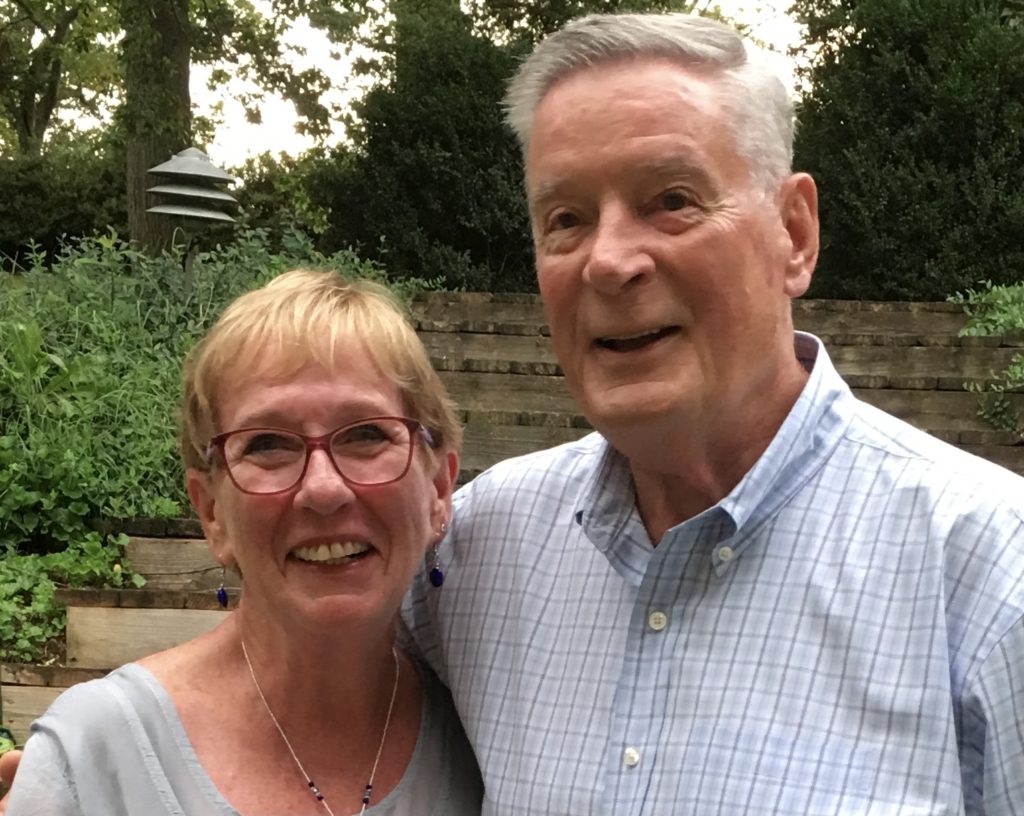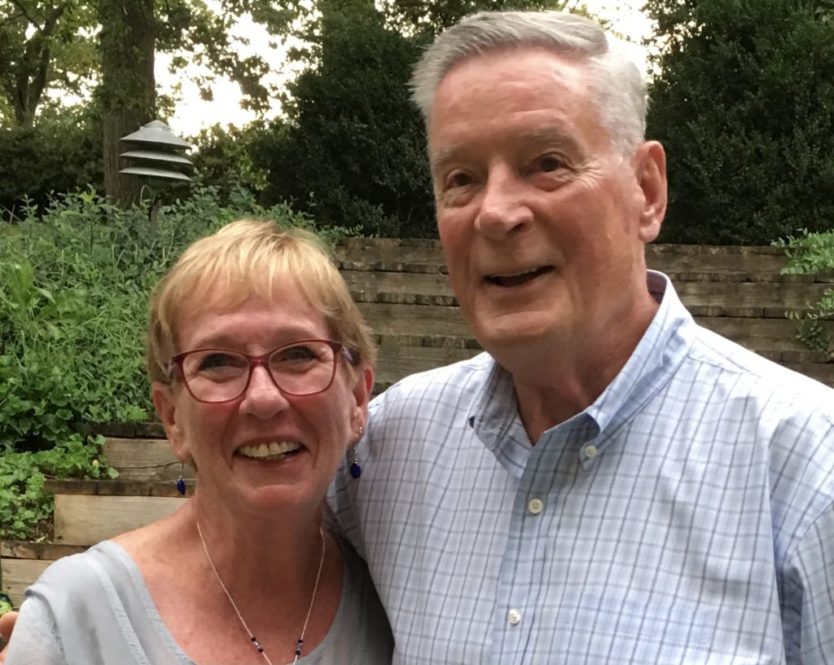Received from Delaware LIVE, October 16, 2021
By BETSY PRICE SEPTEMBER 11, 2021
PEGGY REILLY’S HUSBAND, JIM, ASSUMED SHE HAD BEEN KILLED IN THE SOUTH TOWER COLLAPSE.
Peggy Reilly only wears shoes she can run in.
It’s a lesson the Milford resident learned in 2001 on the 13th floor of the World Trade Center’s North Tower when American Airlines Flight 11 slammed into the building 80 floors above.
Reilly was standing in the office of her friend and Instanet Corp. coworker Barbara Galanaugh at 8:46 a.m., showing Barbara a photo of her new great-nephew Brandon, when the building shook so hard it knocked Galanaugh across the room.

The two women thought there must have been an earthquake. They could see glass and pieces of paper falling outside the windows.
Then the tower started swaying alarmingly.
“That building naturally swayed because of the way it was built,” Reilly remembered. “It was supposed to naturally sway. But it was swaying way more than I was comfortable feeling.”
“We need to get out of here,” she told Barbara.
They gathered the other three office early birds — the rest of the staff didn’t come in until 9 a.m. or a little later — and headed across the building to the B stairwell. Parts of those stairs are now in the 9/11 Memorial Museum.
Reilly abandoned her purse, assuming she’d be back in the office at some point. She was wearing a company polo shirt, khaki pants and clogs, which were fashionable then, but Reilly realized she was never going to be able to run in them.
She kicked them off.
“I went out barefoot, which was probably the biggest mistake I made the entire day,” she said.
This is the first time Reilly has talked to media about that day. While she talks to family and friends, and it sometimes comes up in conversations, Reilly has only talked in public about it once. That was to the Milton Fire Department. There, she kept the story brief and left out a lot of details because there were children in the crowd.
“I’ve never really talked about it because I feel really blessed,” she said. “And I felt really guilty because I was 52 at the time, and I didn’t understand why God saved me and not some of those 20- and 30-year-olds. So I had a lot of guilt for a long time.”
Sept. 11, 2001, started normally enough for her. She got up early and worked out. as she always did. Instead of walking to the Hackensack train station, she was dropped off by her retired husband, Jim, about 7:15 a.m.
Reilly took the train to Hoboken, where she transferred to the Waterways Ferry that took her to the World Trade Center. She stopped at Starbucks for her usual grande black coffee and made the 10-minute walk through the North Tower before arriving at her 13th floor office.
“Not a lot of buildings have No. 13 floors, you know,” she said. “They skip it. In New York, they always skipped it. But the World Trade Center did not skip it.”
Instanet is an electronic trading company, and Reilly was the vice president of client relations for them.
Reilly was the one who insisted her small group head down the stairs. They stopped on the 10th floor, where there were more Instanet offices. No one there could reach the building’s command center.
As the group came out of the office, they met firefighters going up. The firefighters told them to return to their own floors.
Reilly refused.
“I remember saying something like, ‘You know I’m a kid from the 60s. I just can’t listen to you. I feel like we need to get out of the building,’” she said. “It’s that fight or flight thing that you go into. I never knew which I would do.
“And I was the person that said we have got to get out, we have got to find safety. I was totally focused on getting my team out.”
Only one person didn’t follow her down, Stephen Malvey. His father was a fireman, and Malvey felt honor bound to follow their instructions. He returned to their offices, where he went into the kitchen — a windowless room that prevented him from seeing what was happening outside — and washed dishes.
“He was doing these mundane tasks waiting to be told he could evacuate,” Reilly remembered.
The group grew larger as they headed down the stairs, increasingly smelling of gasoline. At some point, someone opened a door and smoke began to billow out. Everyone yelled to close it.
At the mezzanine, they met other people and headed toward the down escalator. Windows were broken, there was a lot of debris and Reilly realized that what she thought was water on the floor actually was gasoline.
“You kept hearing this boom, boom, boom,” she said. “Every time you heard it, you knew what it was. You knew it was somebody who made a decision or fell in the smoke.”
She would not watch them.
The group was steered through the Marriott Hotel there and dodged ambulances to cross West Street.
“We were trying to figure out what we were going to do next, and we hear this unbelievable noise coming over our head,” she said. “I look up, and somebody said, ‘That’s a United flight.’ I said, ‘They’re not allowed in this airspace. I don’t understand what they’re doing.’
“And then I hear them rev those engines and I watched that plane go right into the South Tower.”
That was 9:03 a.m., when United Airlines Flight 175 hit the South Tower.
People on the street started screaming that the country was at war and rushing for buildings. Reilly insisted her group stay outside.
One man in the group had what Reilly thinks was a Nextel phone he used to keep in touch with his girlfriend. It was unusual because few people had cell phones like they do today, she pointed out. She asked him to call her husband and let him know she got out.
Just then, the pager on her belt went off, saying President George W. Bush had announced the country was under attack by terrorists.
The group couldn’t decide to what to do next.
Reilly remembers seeing a woman who has having a terrible asthma attack and who couldn’t stop watching the people jump from the burning building. Reilly gently turned her toward the Hudson River, telling her to look at the water because water has a calming effect.
One of the women in her group had a gym bag, and even though her gym shoes were a size too small for Reilly, she put them on. She had broken her toe, and her feet had been badly cut by glass and still had bits in them, but Reilly hadn’t felt it happening.
They stood there long enough that they watched the South Tower collapse at 9:58 a.m.
“It was surreal,” she said. “All of a sudden you see this plume of smoke. We were close enough that we knew it was going to come towards us.”
She had everyone grab pieces of the woman’s stinking gym clothes and cover their faces.
It was just like what people see on television replays, she said, with billowing clouds of ash and smoke engulfing them.
“All those ashes just covering your body, covering your body,” she said.
Oddly, she said, she doesn’t remember how it sounded.
“I would imagine that this noise was so big, but I think I was probably in shock at that point,” she said. “I don’t really recall. To me, there was no noise. You just watched it implode. I know there was noise. I mean there had to be noise, but I don’t remember it.”
Reilly told the group they had to get out of there.
They headed to Battery Park, where they caught the last ferry to Staten Island before Manhattan was closed off. She made everyone put on a life vest and sit on the side of the ferry away from the Statue of Liberty, which she was afraid might be attacked next.
The passengers watched the North Tower collapse at 10:28 a.m.
On Staten Island, the group walked from store to story trying to find one that would let them use their phones. Reilly had no money or ID. The first three stores refused to allow them in.
When a store finally did, they were all able to call friends and family. That’s when Reilly found out that her husband had been calling friends and family telling them it was over and that she must be dead.
“To be honest with you, it was harder on my husband at the time than it was on me, because I always knew where I was, but he didn’t,” she said.
Barbara Galanaugh’s mother lived in Staten Island and she took them all in. Reilly remembers sitting in the mother’s formal dining room while she and another person picked the glass out of her feet.
When the bridge reopened at 7 p.m. Galanaugh’s mother let Reilly borrow her car to drive home to Hackensack. It’s a trip that usually takes 45 minutes. This one took four hours because of all the road closings, Reilly said.
“I knew I wanted to get home,” she said. “I know my husband needed to see me.”
The Reillys home was in the path of air traffic from Newark Airport, LaGuardia Airport and Teterboro Airport. With flying banned because of terrorism fears, the couple’s next few nights were eerily quiet.
The following Sunday was Reilly’s birthday, and she went to church with Jim. After the Mass, she went up to the priest and told him she felt awful for surviving when thousands did not.
“And he said, ‘There’s a reason for you to be a survivor,’” Reilly remembered. “‘You will find that reason.’”
She has come to believe that it’s to listen to everyone’s stories of the day.
When it comes up in conversation that she used to work on Wall Street, people always ask where she was on 9/11. She tells them.
“They want to touch you, they want to talk to you and they want to tell you their story,” she said. “I feel like that’s an important part of what I need to do. When people talk to me, they need to be able to tell their story, because their story is just as important. Jim’s story was just as important. You know, he was much more scared than I was because I at all times knew I was OK.”
Reilly had nightmares about the day for a long time, but they ebbed away. She does have nightmares about someone chasing her to kill her, and she wonders if they are related.
A normally effervescent person, she no longer can stand to be in crowds and will not go into a movie theater unless the lights stay on during a movie.
“I just need to see who is around me,” she said. “I don’t know why.”
Stephen Malvey did escape later, Reilly said.
Her company only lost two people, IT executives who had been in a meeting at the Windows on the World restaurant at the top of the North Tower.
When one of them, Stephen Thompson, realized he wasn’t going to make it, he picked up the phone and called a colleague and said, ‘I’m going to do a brain dump until I can’t do it anymore.” Thompson proceeded to tell him all the technology information Thompson thought the man needed to know. Thompson’s wife now gives out an annual STEM scholarship in his name.
The Instanet crowd who escaped together stay in touch, in person and on a private Facebook page. All of them have had some kind of health issue since. Reilly’s is asthma, which showed up a few years ago. Their health is monitored every two years by the World Health Organization.
Reilly and Galanaugh have spent every anniversary together. They planned to be together Saturday.
For the first time, Jim won’t be with them. He died in November, making this anniversary even harder for Reilly.
On every anniversary of the attacks, Jim would watch news reports about it, crying throughout them. Reilly never could watch.
But she did this year, a way of honoring Jim. It’s only the second time she’s seen video of the towers collapsing.
“To me, it was just surreal. That was a surreal day,” she said. “You know, you’re living through it, but you’re not thinking. You’re just trying to figure out what your next steps are gonna be.”
She left Instanet a few months after the attacks, because of internal politics. The change sparked the Reillys’ move to Milford. She assumed she’d never find another job in the industry, but did. After 13 years, she retired, too.
Reilly said she and other survivors feel more stress around anniversaries, as news programs began repeating video and stories.
She recently burst into tears on the fifth green of a golf course, and she assumes it was caused by a breakthrough of anniversary stress.
On Facebook Saturday, she wrote about the firemen and police officers headed up the stairs. While she was going down to save her life, they were heading toward the ultimate sacrifice, she said.
She wants people to remember them, the innocent victims of the attacks — and the history of the day.
Reilly grows irritated with younger people who want the world to be about peace and love and therefore recast what happened.
“You need to realize that there are good guys and bad guys,” she said.
She believes this year’s anniversary difficult not only because it’s a milestone year, but also because of what’s happened in Afghanistan.
“I really hope the school systems continue to teach 9/11,” she said. “It’s like Pearl Harbor. It’s like World War II. It is a day in history that needs to never be forgotten.”
Reilly finds the days of service that people and organizations do in memory of those who died in New York, the Pentagon and Shanksville a worthy memorial.
She also remains struck by the unity that swept the country after the attacks.
“This was our country. You could be a Democrat, Republican, you could have been a Communist that day, but if you were living in the United States, you were one American people,” she said. “I would love to see that again.”


